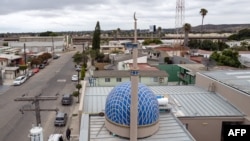U.S. intelligence and security officials are increasing their focus on the country’s southern border, worried the constant flow of migrants has attracted the attention of the Islamic State terror group.
The heightened concern follows the arrests earlier this month of eight men from Tajikistan, all of whom entered the United States via its southern border with Mexico, some making the trip over a year ago.
While the initial background checks came up clean, U.S. law enforcement subsequently turned up information indicating potential ties to the Islamic State group, also known as IS or ISIS.
“It's not lost on us that the people who killed over 150 Russians in that theater were from the same part of the world," said Ken Wainstein, the U.S. Department of Homeland Security’s undersecretary for intelligence and analysis, referring to the March attack on a Moscow concert hall, claimed by the terror group’s Afghan affiliate.
Wainstein, testifying Wednesday before the House Homeland Security Subcommittee on Counterterrorism, said concern about the potential for IS to exploit the border has led to daily meetings with the director of the U.S. National Counterterrorism Center (NCTC), as well as unprecedented cooperation with the FBI.
But he sought to downplay concerns stemming from intelligence suggesting that the IS-linked human smuggling network may have brought more than 400 migrants from Central Asia into the U.S., across the southern border.
“There is not information which suggests those particular individuals are terrorist operatives," Wainstein told lawmakers.
Information on the 400 migrants, first reported by NBC News, indicates more than 150 of the migrants have been arrested. But officials told NBC that the whereabouts of more than 50 others are unknown.
The newfound concerns about terror groups like IS actively trying to exploit the southern border seems to indicate a significant shift in the threat landscape.
For years, U.S. counterterrorism officials have maintained there was no evidence that IS or other Sunni terror groups were trying to infiltrate the U.S. along its border with Mexico.
And this past November, NCTC Director Christine Abizaid told lawmakers that while counterterrorism officials “absolutely recognize the risk,” evidence for such plots was lacking.
“We don’t have indications that are credible or corroborated,” she told members of the House of Representatives at the time.
But U.S. and Turkish sanctions unveiled earlier this month may point to the Islamic State terror group’s growing interest in human smuggling.
The sanctions focus on what the U.S. Treasury Department described as a Eurasian human smuggling network that was providing support for IS members in Turkey.
One of the key operatives, Olimkhon Ismailov, is based in Uzbekistan. And Ismailov had high-level help, with Treasury alleging he was given guidance by the leader of IS in the Republic of Georgia, Adam Khamirzaev.
According to the U.S. State Department, Khamirzaev apparently had his sights set on the U.S.
The IS-Georgia emir “provided guidance to this network on a range of activities supporting ISIS and was aware of its efforts to facilitate travelers to the United States," the State Department said in a statement.
Multiple U.S. agencies, including DHS, the FBI and the State Department declined to respond to questions about the reach of the Eurasian human smuggling network involved with IS operatives in Turkey and Uzbekistan.
There are also no indications that the sanctioned network is connected to the same IS-linked network that brought the eight men from Tajikistan, or the hundreds of other Central Asian migrants, into the U.S. through the southern border.
As for the eight men from Tajikistan, Homeland Security Secretary Alejandro Mayorkas told reporters in Tucson, Arizona, Wednesday that, “They are in removal proceedings as we speak.”
And other U.S. officials say they have stepped up security measures.
"We have increased our vigilance at our border," said Jen Daskal, the White House deputy Homeland Security adviser, virtually addressing a counterterrorism conference Wednesday in Omaha, Nebraska.
“We have enhanced our screening and vetting, instituted recurrent vetting of migrants to identify newly uncovered threats and detain those who pose a public safety threat,” she said.
But Daskal admitted the threat from IS, and especially its Afghan affiliate, persists.
"Both ISIS and ISIS-Khorasan, or what we call ISIS-K, have demonstrated a capability and intent to conduct external operations,” she said.










